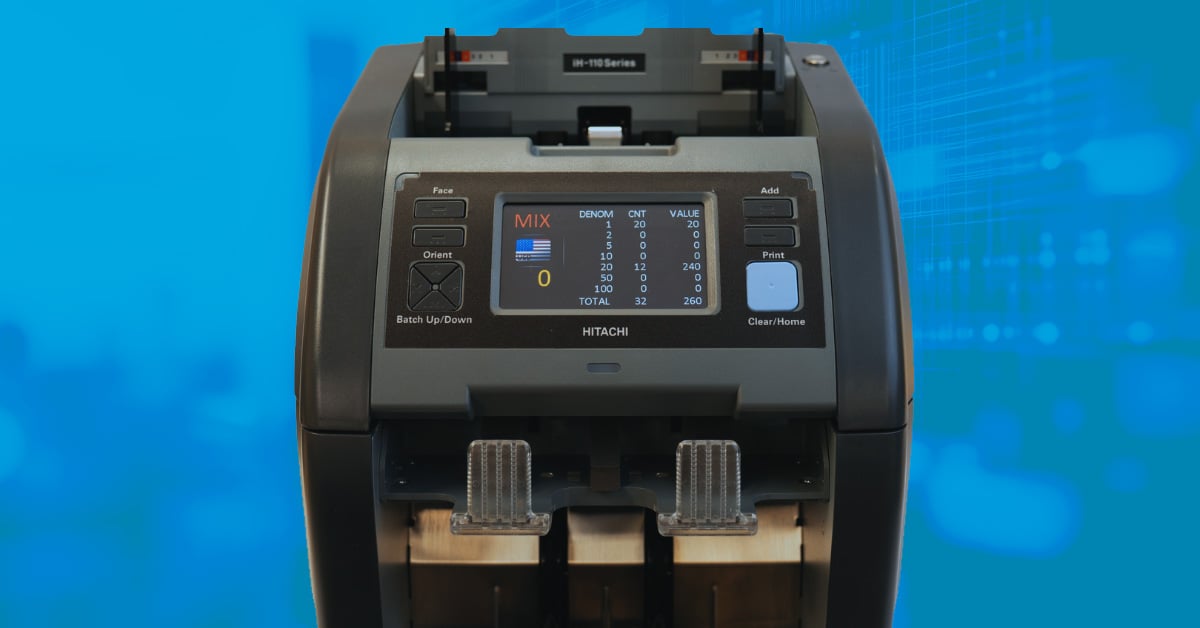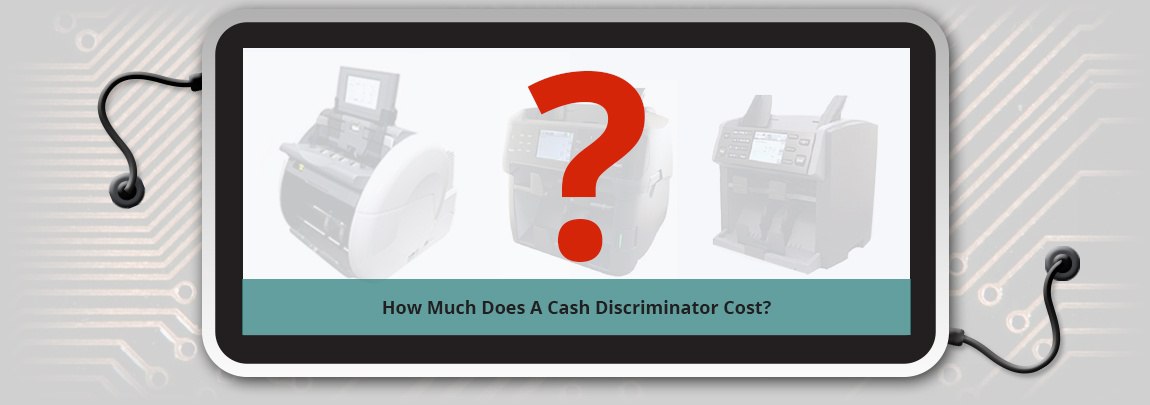Basic Currency Counters vs Cash Discriminators
Every year a variety of clients ask us if they need a cash discriminator or will a basic counter meet their needs The clients range from Banks and...
7 min read
 Sean Farrell
:
Jun 6, 2025 8:00:00 AM
Sean Farrell
:
Jun 6, 2025 8:00:00 AM

If you're running a branch, a retail operation, or a team that handles a high volume of cash, chances are you've already felt the drag of inefficient bill counting … even if you haven't called it that yet.
Maybe your current process still works "well enough," but it comes at a cost. Recounts. Miscounts. Staff pulled off the floor to spend 20+ minutes verifying a deposit that should take five. Overtime hours. Customer complaints. A growing sense that your processes haven't kept pace with your service expectations.And if you're in a leadership role (in ops, finance, or frontline service) you're left trying to reconcile the two. You want faster, cleaner transactions. You want to protect your margins and reallocate staff time. You want a cash handling process that actually matches the rest of your customer experience.
If any of that sounds familiar, this guide is for you.
We'll walk through:
The day-to-day problems that modern mixed-bill cash counters solve, and the less obvious pain points they quietly eliminate
Where cash counting technology fits into your broader efficiency, staffing, and CX strategy
The real questions to ask before you select a machine (and what mistakes to avoid if you want long-term ROI)
What to expect operationally (and within your team culture) when you make the switch
Today's conversation isn't geared toward trying to get you to buy fancier hardware. It's about equipping your team with tools that support the way you actually work today, and the way you want to serve your customers tomorrow.
When we talk to leaders about their current cash handling process, most of them say the same thing: "It's not perfect, but we've made it work."
And they have. But making it work often means asking your people to spend too much time on workarounds that were never meant to scale. Or worse, burning time and money on avoidable mistakes.
The right mixed-bill counter doesn't just count faster. It solves for accuracy, trust, and time all at once. And if you've ever had a frontline employee stop what they're doing to count a drawer twice (or a customer raise an eyebrow over a $20 discrepancy), you already know how fast those little problems become big ones.
Here's where modern machines make the biggest difference:
Whether it's a miscount or a mixed denomination slipping past your team, every manual error creates drag. A customer's deposit comes up short. A drawer's off by $100. Now you're recounting, retraining, and hoping it doesn't happen again. The right machine reads denominations, flags discrepancies, and gets it right the first time, so your staff isn't stuck going backward.
On a good day, an employee might count 100 notes per minute, assuming no one interrupts them. That's rare. Every time someone has to start over or wait their turn, that time adds up. Two-pocket machines reduce interruptions by flagging suspect bills without stopping the whole process. For high-volume environments, that's the difference between staying on pace or falling behind every shift.
This one's hard to measure, but you can feel it. When managers and senior tellers are stuck in the back counting deposits, they're not coaching team members or solving customer problems. In retail, when cash drops take 20 minutes, leadership disappears from the floor. The right tool gives that time back. And with it, the ability to lead from the front instead of scrambling behind the scenes.
You might only hear about it when something goes wrong, but it matters every time. When deposits are fast, accurate, and drama-free, customers feel it. And when they aren't? That erodes trust, especially with business clients who expect precision and don't have time for do-overs.
It's easy to think of a cash counter as just another piece of equipment, a behind-the-scenes tool that helps you balance drawers and move on. But if you zoom out just a bit, you start to see the ripple effects. What seems like a small operational upgrade can create space for bigger, more strategic wins.
Here’s what we mean:
The best teams still struggle when their best people are stuck in the vault. Every minute they spend rechecking deposits or sorting bills by hand is time they're not spending coaching, solving, or serving. That kind of slow bleed doesn't show up on a report, but it shows up in customer wait times, staff frustration, and missed opportunities on the floor.
Even if your strategy is just "find and keep great people." Recruiting and retention have gotten harder. Wages are higher. Expectations are higher. And asking a $22/hour team member to count $20s manually isn't just inefficient, it's expensive. When you upgrade your tools, you give those employees the chance to do higher-value work. You also make the job more attractive, more modern, and more sustainable in the long run.
Your customers expect faster, cleaner, smarter service. They've gotten used to it in every other part of their life. And while no one's walking into a branch or a retail shop thinking about cash counters, they are thinking about how long the line is. Or why their deposit takes 15 minutes. Or whether you're really equipped to handle their business. Modern tools help you close that gap and show that you're invested in getting it right.
By the time someone's ready to evaluate new cash counting machines, they usually have one of two things: a clear pain point or a laundry list of frustrations they haven't quite named yet. Either way, the worst thing you can do is treat this like a simple spec comparison or a price-per-feature exercise.
Not because the hardware doesn't matter (it most certainly does), but because this isn't just about the machine. It's about what that machine enables for your staff, your customers, and your operation as a whole. Here's how to make sure you're buying the right solution, not just the one that looks good on paper:
Before you compare price points, figure out what your day-to-day actually demands. A small retail location handling $1,000 in daily cash flow doesn't need the same machine as a high-volume branch processing armored car deliveries. Get honest about your volume, your environment, and how much time you're losing with your current setup.
Most spec sheets will tell you how fast a machine can count. That's helpful, but misleading. The real question is: how often does it stop? One-pocket machines halt every time they hit a suspect note. Two-pocket and multi-pocket models keep going, separating the bad bill while the rest of the work continues. That's real-world speed, and it matters a lot more than theoretical note-per-minute claims.
If your machine doesn't read denominations, you're counting blind. Modern mixed-bill discriminators are essential if you're handling deposits, processing business cash, or trying to eliminate recounts. If you're sorting by hand first, the machine isn't saving you enough to justify its space on the counter.
This is where a lot of teams get tripped up. They find a model that's "good enough" and affordable, and then they buy it again two two years later. Or worse, they wait a week for service when something breaks. A quality machine with in-market support may cost more upfront, but if it lasts six years and rarely fails, you come out ahead in every way that matters.
If your staff dreads using the machine, it won't matter how capable it is. Look for models that are intuitive, easy to train on, and don't require a 40-minute tutorial to get through a basic task. If your vendor doesn't include install and training (or at least good materials), that's a red flag.
By the time a cash counter hits someone's radar, the urgency is usually real. Maybe a machine just died. Maybe it's been six months of miscounts and make-dos. Maybe someone finally asked the question: “Why are we still doing it this way?”
And when there's urgency, there's temptation — to buy fast, to go cheap, to assume that anything's better than what you've got. But that's where good decisions turn into costly detours.
Here are the most common pitfalls we see — and how to avoid them:
It's easy to anchor on the lowest quote. But what looks like a deal today can quietly become a recurring expense when that unit fails early or needs frequent replacement. If you're spending $1,200 every 18 months on a machine that's only “mostly accurate,” you're not saving, you're subsidizing bad equipment.
If your cash counter goes down, how long are you willing to wait? Some vendors ship loaners and handle service remotely, which means you're waiting days, not hours. That may work for some, but if you need speed and reliability, make sure your vendor has service that matches the stakes.
The sticker price is only one piece. How long will it last? How often will it need service? What does that service cost? And will your team actually use it, or go back to manual work because it's too clunky or unreliable? The right choice pays off in reduced labor, better accuracy, and longer operational life.
This one’s especially common when there's no clear internal owner for the decision. One branch wants something basic, another needs full-featured discrimination and multiple pockets, and everyone ends up with a half-solution. One-size-fits-all rarely fits anyone well.
A cash counting machine, on its own, isn’t going to transform your branch or your business. But the right one (the one that fits your volume, your people, and your pace) can remove the friction that’s been slowing everything else down.
It’s not just about counting faster. It’s about giving your managers time back. It's about creating fewer customer delays and fewer internal bottlenecks. It's about fixing a process that’s been quietly draining your team for years.
So if you’re at the point where you're ready to rethink how cash moves through your operation, don't start by asking, "Which machine is best?”
Instead, here's what you should think about:
What kind of environment are we trying to build?
Where are we wasting the most time right now?
And what would it look like if our tools actually kept up?
If you want help talking that through (no pressure, no pitch), we're happy to be a sounding board. Whether it's us or someone else, you deserve a solution that actually works.

Every year a variety of clients ask us if they need a cash discriminator or will a basic counter meet their needs The clients range from Banks and...

We work with a variety of financial institutions to identify ways to gain efficiency through automation in the retail branch setting. After over 30...

One of the most frustrating and time-consuming transactions at the teller line is the commercial or retail deposit. Some of these transactions can...